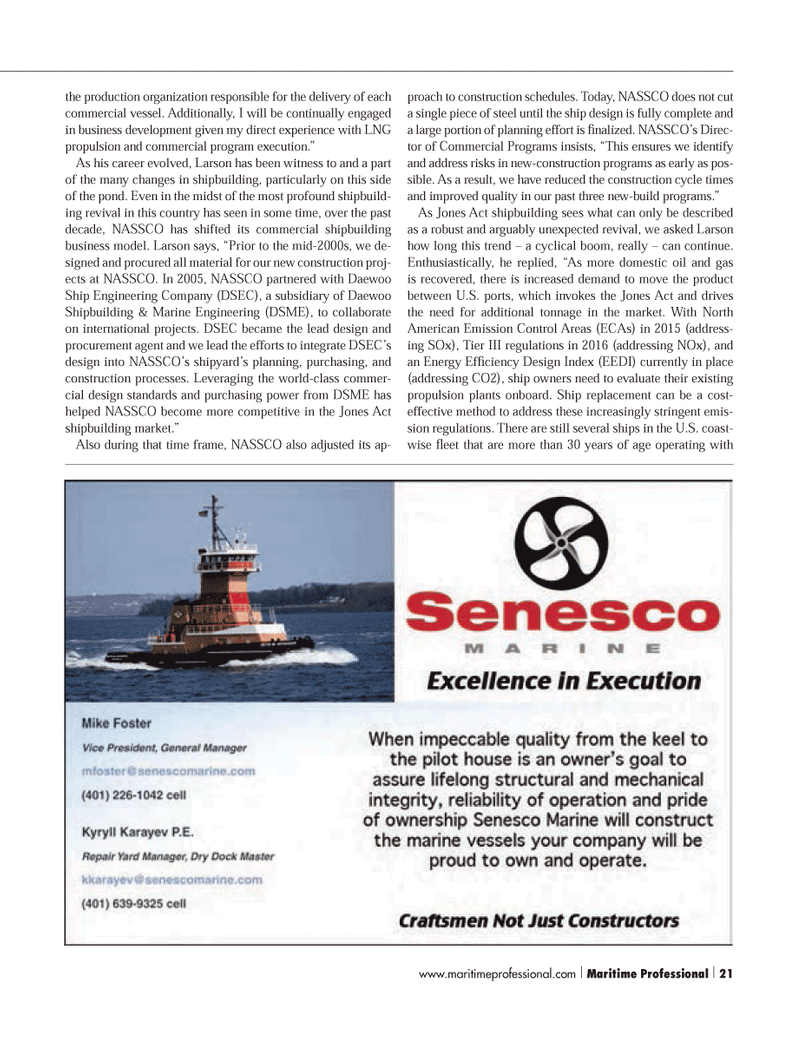
Page 21: of Maritime Logistics Professional Magazine (Q4 2013)
Shipbuilding, Repair
Read this page in Pdf, Flash or Html5 edition of Q4 2013 Maritime Logistics Professional Magazine
the production organization responsible for the delivery of each commercial vessel. Additionally, I will be continually engaged in business development given my direct experience with LNG propulsion and commercial program execution.? As his career evolved, Larson has been witness to and a part of the many changes in shipbuilding, particularly on this side of the pond. Even in the midst of the most profound shipbuild- ing revival in this country has seen in some time, over the past decade, NASSCO has shifted its commercial shipbuilding business model. Larson says, ?Prior to the mid-2000s, we de- signed and procured all material for our new construction proj- ects at NASSCO. In 2005, NASSCO partnered with Daewoo Ship Engineering Company (DSEC), a subsidiary of Daewoo Shipbuilding & Marine Engineering (DSME), to collaborate on international projects. DSEC became the lead design and procurement agent and we lead the efforts to integrate DSEC?s design into NASSCO?s shipyard?s planning, purchasing, and construction processes. Leveraging the world-class commer- cial design standards and purchasing power from DSME has helped NASSCO become more competitive in the Jones Act shipbuilding market.? Also during that time frame, NASSCO also adjusted its ap- proach to construction schedules. Today, NASSCO does not cut a single piece of steel until the ship design is fully complete and a large portion of planning effort is nalized. NASSCO?s Direc- tor of Commercial Programs insists, ?This ensures we identify and address risks in new-construction programs as early as pos- sible. As a result, we have reduced the construction cycle times and improved quality in our past three new-build programs.? As Jones Act shipbuilding sees what can only be described as a robust and arguably unexpected revival, we asked Larson how long this trend ? a cyclical boom, really ? can continue. Enthusiastically, he replied, ?As more domestic oil and gas is recovered, there is increased demand to move the product between U.S. ports, which invokes the Jones Act and drives the need for additional tonnage in the market. With North American Emission Control Areas (ECAs) in 2015 (address- ing SOx), Tier III regulations in 2016 (addressing NOx), and an Energy Ef ciency Design Index (EEDI) currently in place (addressing CO2), ship owners need to evaluate their existing propulsion plants onboard. Ship replacement can be a cost-effective method to address these increasingly stringent emis- sion regulations. There are still several ships in the U.S. coast- wise eet that are more than 30 years of age operating with www.maritimeprofessional.com | Maritime Professional | 21MP #4 18-33.indd 21MP #4 18-33.indd 2112/11/2013 1:04:53 PM12/11/2013 1:04:53 PM

 20
20

 22
22
